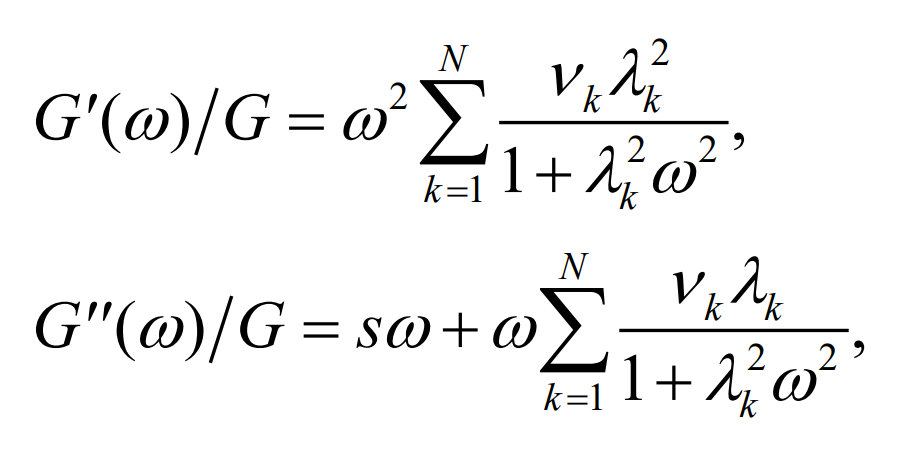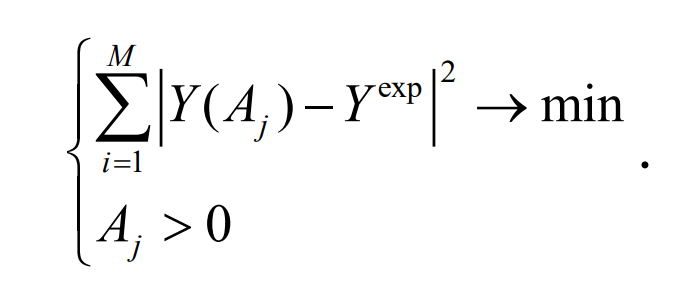AIP Conference Proceedings 2216, 020001 (2020); https://doi.org/10.1063/5.0005279
Y. Bayandin,
D. Bilalov,
O. Naimark,
E. Krutikhin,
V. Zhuravlev
The work is devoted to the development and justification of the rheological model, methods for identifying the model constants for surfactant solutions used to create hydraulic fracturing fluids, as well as methods for modeling the rheological behavior of fracturing fluids in a wide range of deformation rates. The applied significance of the developed model lies in the possibility of carrying out numerical calculations of the processes associated with hydraulic fracturing, which is necessary for efficient oil production.
Introduction
When hydraulic fracturing designing takes place, one of the key parameters is the injection pressure at the wellhead Рw = Рl + Рf − Рh, where Рl – hydraulic fracturing pressure (determined by the properties of the layer); Рf – pressure loss due to friction in the pipes; Рh – hydrostatic pressure of a liquid column in a well. The pressure loss Рf is mainly determined by the rheological properties of the proppant holding fluid; therefore, the urgent task is to justify the choice of the concentration of a viscoelastic surfactant in the preparation of a fracture fluid. In domestic practice, it is customary to use a fracturing fluid with an effective viscosity of 0.4 Pa•s (~400 cP) at a strain rate of 100 s−1 and a temperature equal to the arithmetic mean between the temperature of the formation and wellhead. In recent years, foreign literature increasingly mentions the elastic component of the fracturing fluid as the most adequate characteristic correlating with the proppant holding capacity of the fluid. In this regard, it is neccesary to develop mathematical models and methods for calculating the proppant holding capacity of a fracturing fluid, depending on its viscoelastic characteristics. The dependence of the mechanical properties on the relationship between the relaxation times of a media and the characteristic loading times, as experiments show, is not only a property of solids, but is also valid for liquids in a wide range of deformation rates. The study of the viscoelastic behavior of fluids exhibiting finite elastic deformations involves the generalization of known thermodynamic approaches for essentially non-equilibrium systems, the development of methods for simulating laboratory rheometric tests. It is fundamentally important to create new equipment for verification of the determining relationships of the behavior of liquids in a wide range of deformation rates, taking into account the mechanisms of development of flow instabilities. The solution of these problems is the basis for modeling the conditions of effective hydraulic fracturing, designing of pumping equipment to increase oil recovery.
The aim of this work is the development and implementation of approaches and methods for determining the constants of rheological models for a few of surfactant solutions, methods for modeling rheological behavior in a wide range of deformation rates. The identification of the parameters of the rheological model is carried out on the basis of standard tests using a rotational rheometer. The dynamic characteristics (real G' and imaginary G" parts of the elastic modulus) are estimated in the oscillation mode for a frequency range typical of operating times. Modeling of processes occurring during hydraulic fracturing will reduce the cost of field experiments, as well as the costs associated with possible errors in the incorrect assessment of the properties of viscoelastic surfactants used.
Viscoelastic fluid models
In modern hydraulic fracturing simulators, rather simple rheological models are used to speed up computation [1–4]. So, in most approaches, the fracturing fluid appears to be Newtonian (linearly viscous) or nonlinear quasiNewtonian (pseudoplastic) media with an effective viscosity that depends on both the fluid composition and the flow process parameters. Consideration of the elastic component of gelling agents in solutions of propellant-based liquids based on viscoelastic surfactants is not sufficiently studied. Therefore, the development of physically based models taking into account their viscoelastic properties is necessary. A sufficiently large number of rheological flow models have been proposed for polymer solutions, but only some of them are widely used, others are not used possibly due to their complicity or the difficulty of identifying model parameters from rheological experiments. We mention only the most common models, which are generalization of the theory of the Maxwell flow: Oldroyd-B [5], K-BKZ [6], Giesekus [7], Phan–Thien–Tanner [8], Leonov–Prokunin [9, 10], Vinogradov–Pokrovskii [11, 12]. In the linear region of viscoelasticity, most models give similar results for both static viscosity and dynamic characteristics (components of the complex elastic modulus G' and G''). Differences are observed in the nonlinear region of viscoelasticity. The Oldroyd-B model describes the behavior of a linear viscoelastic medium and is mainly applicable to fluids with constant shear viscosity. The remaining indicated models take into account nonlinear effects of viscosity. The Giesekus and Phan–Thien–Tanner models allow the formulation of constitutive equations in differential form with one or two nonlinearity parameters and allow the separation of the viscous stress tensor into the contribution of the polymer and solvent. The rheological model K-BKZ is formulated in an integral form and is most used for simple flows, for example, shear ones. The disadvantage of the last is the difficulty in determining the integral core for complex flows of liquids. The Vinogradov-Pokrovskii and Leonov-Prokunin models are less common, since the description of three-dimensional flows causes certain difficulties in identifying the parameters. Proppant holding fluids are viscoelastic surfactant based solution consisting of micelles of various configurations. Solutions consisting of micelles are thermodynamically stable systems and consist of non-polar hydrocarbon chains of surfactant molecules. Thus, the mechanical properties (in particular, rheological) of viscoelastic surfactant solutions can be considered from the same standpoint as polymer solutions. The Leonov-Prokunin model will be used to describe the viscoelastic fluid rheology, since it explicitly takes into account the elastic and viscous components of the chains strains of surfactant molecules from non-equilibrium thermodynamics basis.
Two types of viscous-elastic surfactant fluids based on the Surfogel brand D and Guar were considered. The studies were carried out on a Grace M5600 rheometer at a temperature of +25 ºС. The compositions of the fracturing fluids are presented in tables 1 and 2. The shear rate in static experiments was set in the range from 1 to 1000 s–1 . The dependences of shear stress on shear rate are obtained. Additionally, oscillation tests were carried out for both fluids at a temperature of +25º and a frequency in the range from 0.1 to 5 Hz. The dependences of the storage modulus G' and the loss modulus G'' versus frequency are obtained.
| Component | Weight, % |
|
Surfogel brand D (surfactant base, type 70-100) |
9.51 |
| Surfogel brand D (activator) | 1.81 |
| distilled water | 88.68 |
| Component | Weight, % |
| Guar brand HydraGEL 8F | 0.32 |
|
Stapler brand HydraXW-2 |
0.36 |
| distilled water | 99.32 |
The main equations of the model are presented in the works of the authors [9, 10]. An advantage of this type models is the thermodynamic description of the elastic contribution by explicitly introducing the potential energy of interaction of the polymer chains, which in turn depends on the internal variables characterizing their deformation properties. The structural-mechanical model is a set of parallel connected Maxwell chains with specified values of relaxation time and shear modulus. The dependence for the stationary shear flow stress depending on the shear strain rate:

where σ − shear stress, Г=γ*θ − dimensionless strain rate, s, νk, λk − dimensionless constants. Here, the viscosity of the entire system is defined as η=G θ, where G is shear modulus, θ is the relaxation time, the parameter 0 ≤ s < 1 characterizes the contribution of linear (Newtonian) viscosity, the additional terms under the sum determine the nonlinear contribution to the viscosity, and the dimensionless parameters specify the ratio of relaxation times λk= θk / θ and shear modules νk = Gk / G for parallel connected Maxwell elements, respectively. The dynamic characteristics for both liquids were studied according to the data of oscillation tests on a Grace M5600 cylindrical rheometer. The dependences of the real part G' and imaginary part G'' of elastic modulus were set as follows:

where ɷ is a frequency. Similar relationships were proposed in the K-BKZ model [6].

FIGURE 1. Stress vs. strain rate diagrams for liquids based on viscoelastic surfactants Surfogel brand D (a) and Guar (b)

FIGURE 2. Real G' and imaginary G'' parts of elastic modulus for liquids based on viscoelastic surfactants Surfogel brand D (a) and Guar (b)
The identification problem was solved in such a way as to estimate model parameters that approximate well enough both static and oscillation tests. Thus, the problem of determining model parameters , θk, νk,θ,s from the experimental data has the following form:

Here Y={σ,G',G''} are the experimentally measured values, M is the number of experimental points, Aj0={θk,νk,θ,s} are model parameters, k=1..N. The number of Maxwell chains N was taken equal to 2, which is sufficient to describe the nonlinear nature of the behavior of the considered liquids. It was shown that N<2 is insufficient for a satisfactory approximation of the experimental data, and N>2 does not give the best result for the liquids under consideration.
The optimization problem was solved numerically using direct search method. The results of the task of identifying model parameters for static experiments are presented in figure 1. The numerical simulations of viscoelastic deformation are shown by a solid line, and the experimental results are shown by dots. It should be noted that the characteristic relaxation time determined by the stationary test corresponds to a frequency of 0.3 Hz, after which the Guar-based fluid sample behaves like an elastic body. For liquid based on viscoelastic surfactants Surfogel brand D estimated characteristic frequency is 4 Hz. The results of approximation components of the complex elastic modulus G' and G'' are presented in figure 2.
Conclusion
The identification procedure of the model parameters for two types of fluids based on the viscoelastic surfactant Surfogel brand D and Guar is carried out. The applicability of the Leonov–Prokunin model of a viscoelastic fluid for static rheological tests and oscillation tests is shown. It was also established that in the oscillation up to 0.3 Hz (the point of intersection of the dependences real G' vs. imaginary G'' parts of elastic modulus) the guar-based fluid behaves as Newtonian type, and for frequencies greater than 0.3 Hz – as Maxwellian type. The corresponding transition frequency for a liquid based on the viscous-elastic surfactant Surfogel brand D is 4 Hz.
Acknowledgments
The reported study was funded by the Russian Foundation for Basic Research, project number 19-48-590016.
References
1. A.P. Peirce, Comp. Methods in Appl. Mech. and Eng. 283, 881–908 (2015).
2. E.V. Dontsov and A.P. Peirce, Methods in Appl. Mech. and Eng. 313, 53–84 (2017).
3. A.M. Linkov, arXiv: 1905.06811 (2019).
4. V.A. Kuzkin, A.M. Krivtsov and A.M. Linkov, J. Mining Sc. 50(1), 1–9 (2014).
5. J.G. Olroyd, Proc. Roy. Soc. 200, 523–541 (1950).
6. E. Mitsoulis, ISRN Polymer Science, 952379 (Hindawi Publishing Corporation, 2013), 22 p.
7. H. Giesekus, J. Non-Newtonian Fluid Mech. 11(1/2), 69–109 (1982).
8. N. Phan-Thien and R.I. Tanner, J. Non-Newtonian Fluid Mech. 2(4), 353–365 (1977).
9. A.I. Leonov, Rheologica acta. 15(2), 85–98 (1976).
10. A.I. Leonov et al., Rheologica Acta. 15(7-8), 411–426 (1976).
11. G.V. Vinogradov et al., J. Polymer Sci.: Part A-2. 10(6), 1061–1084 (1972).
12. G.V. Pyshnograi, A.S. Gusev and V.N. Pokrovskii, J. Non-Newtonian Fluid Mech. 163(1-3), 17–28 (2009).
